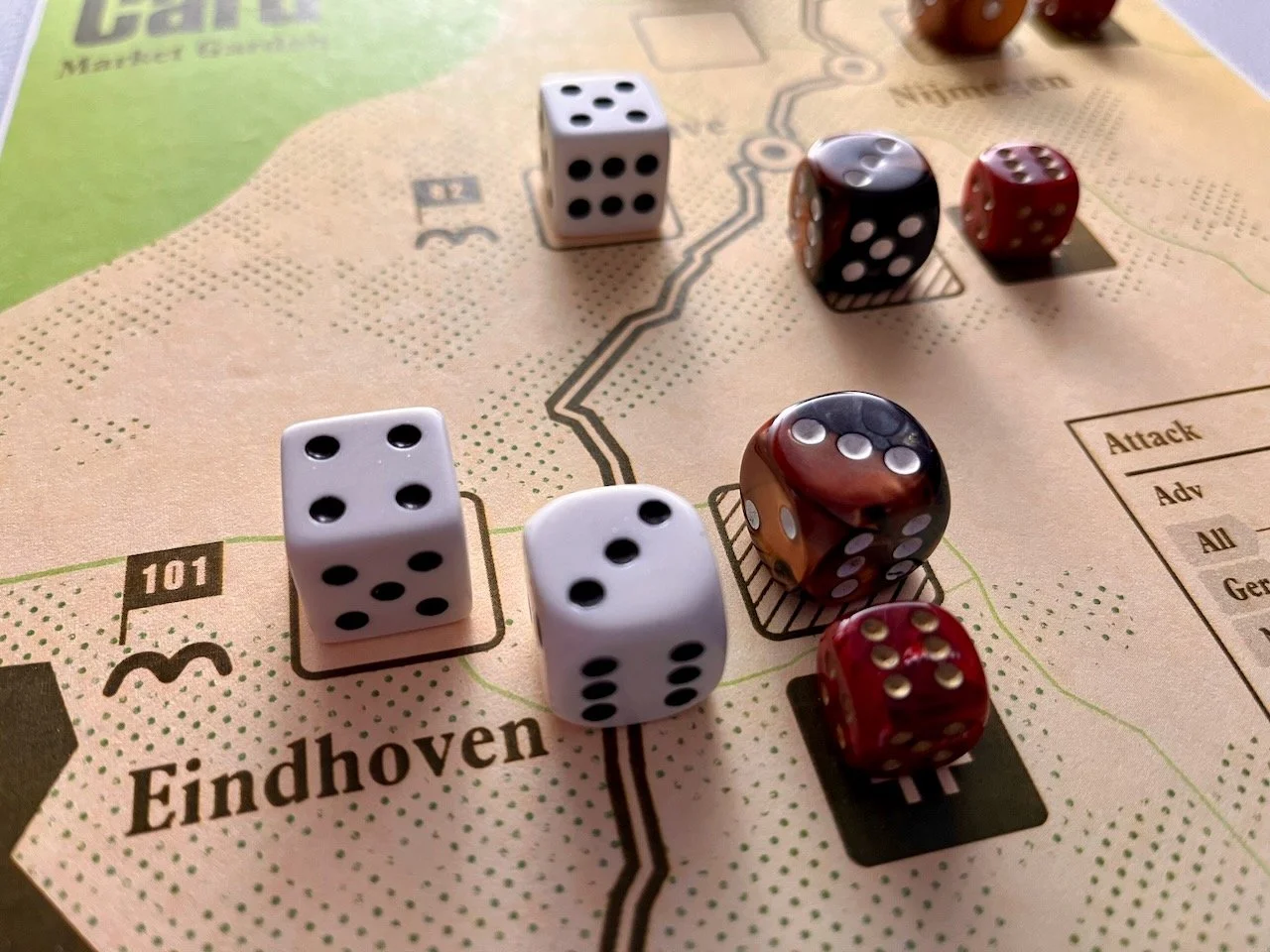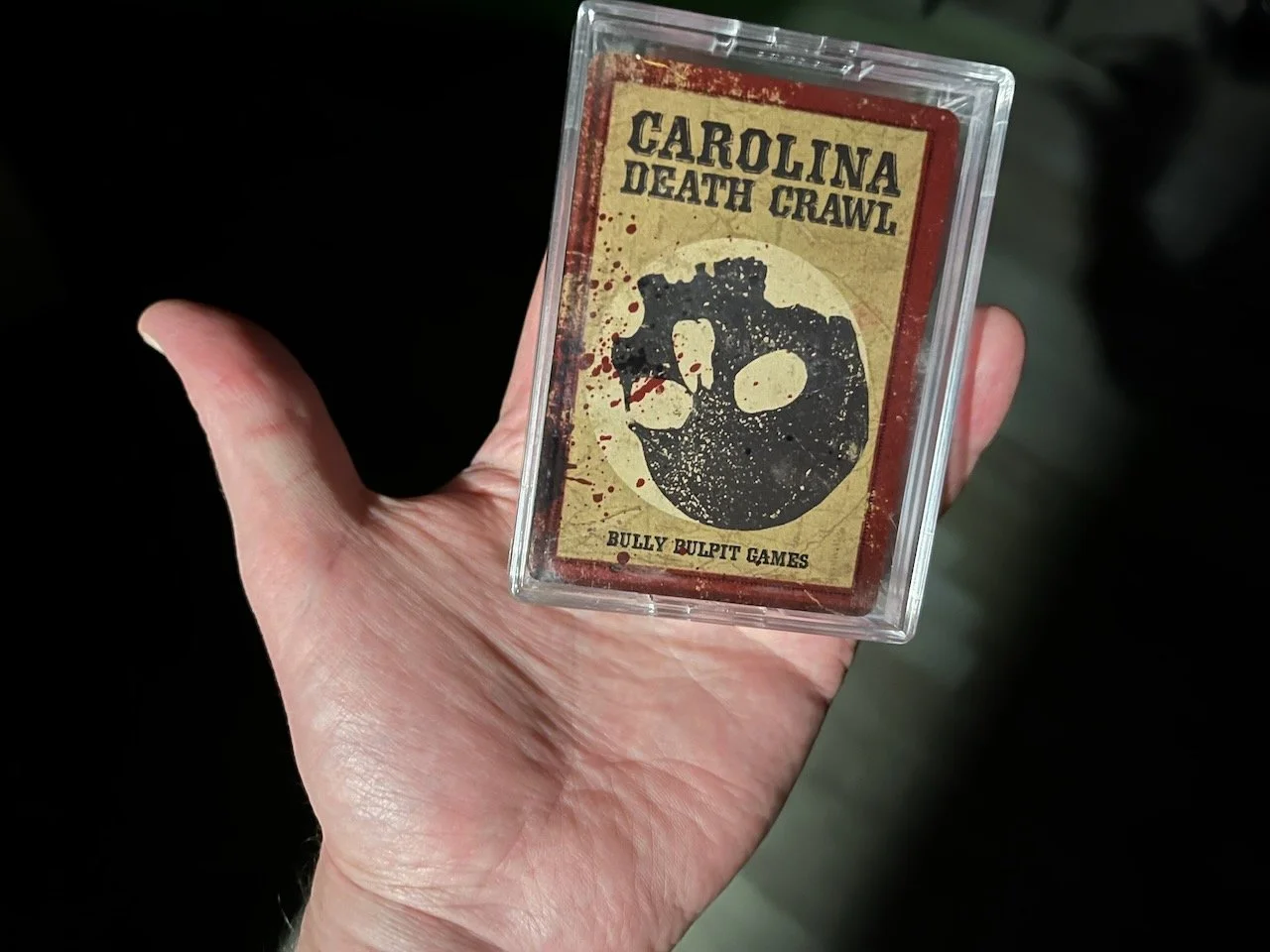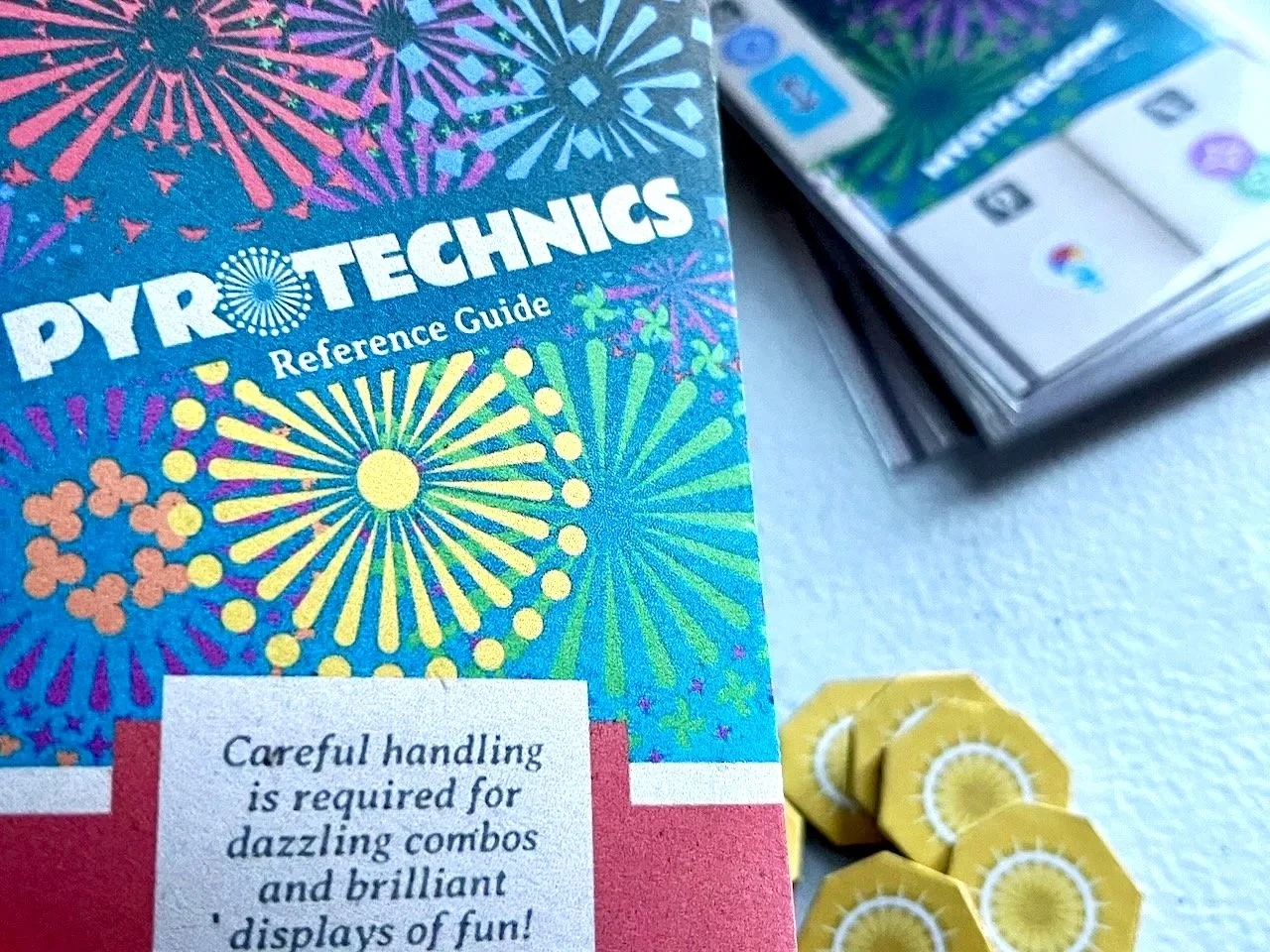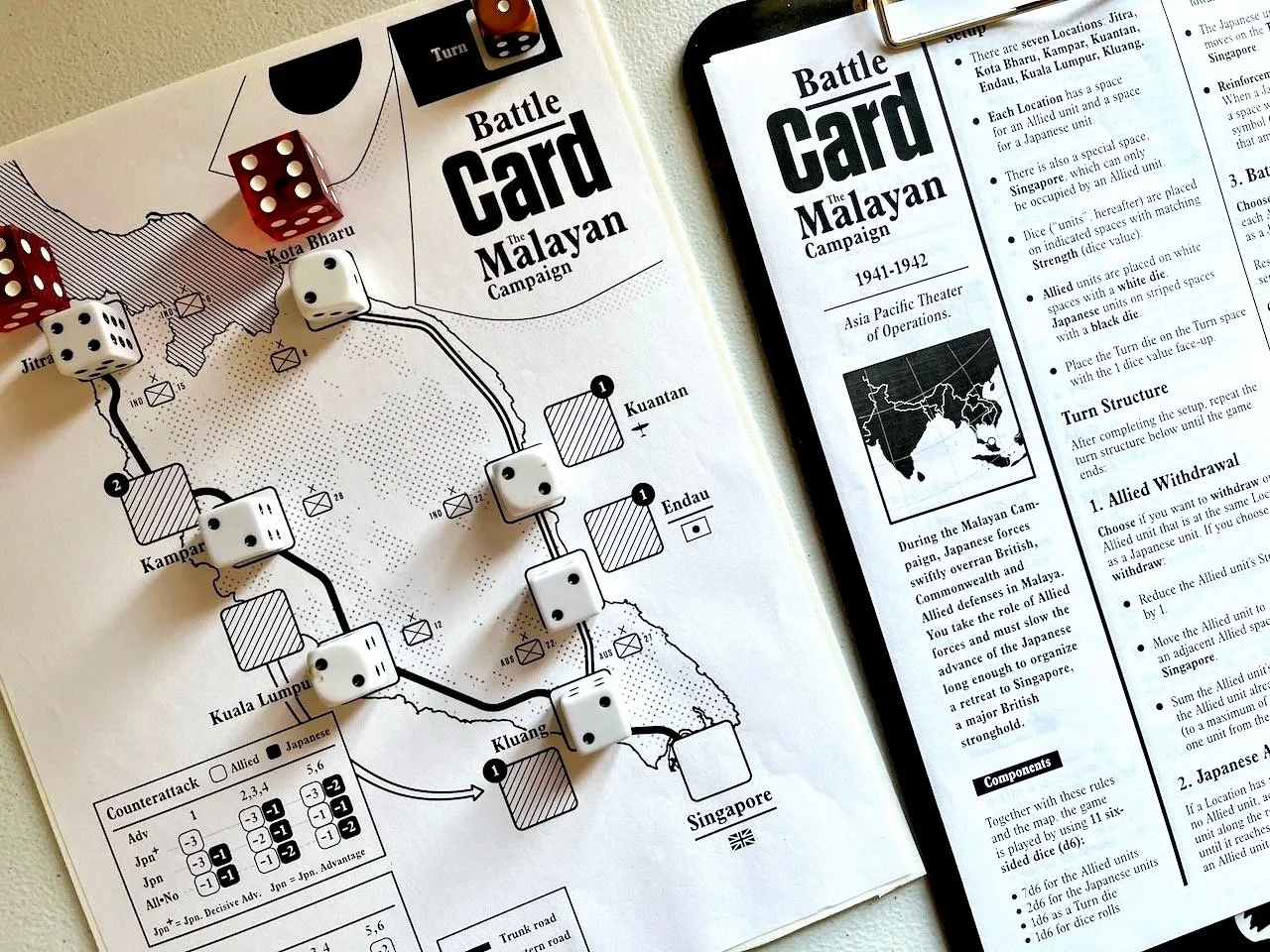Battle Card from Postmark Games: Six Tidy and Clever WW2 Battles
Battle Card’s care in detailing, visual presentation, affordability and accessibility should endear it to non-wargamers and historical gamers looking for a fun afternoon of solo play.
This is adapted from the script of Episode 99, Battle Card Review + Meet The Lads of “War With a Mate”
When the Imperial Japanese Army hit Malaya, British Commonwealth forces — including Indian and Malayan troops — got rolled up like a taco. The Allies blew up something like 100 bridges as they fled south and the Japanese still ran them down in just over two months.
So here I sit in front of the first of six campaigns of Battle Card, a collection of WWII print-and-play titles from Postmark Games. It takes about five minutes of setup to see where the design logic and the historical situation come together on my little map, upon which sit a bunch of six-sided dice that portray the strength and position of the forces: a string of two-strength Allied units against two max-strength Japanese units.
One sheet of rules and dice that you supply get you off and running (for your life) in The Malayan Campaign, one of six WW2 “battles in a bottle” that come with Postmark Games’ Battle Card print-and-play solo game.
Looking from the Allied seat, you’re supposed to craft a successful fighting retreat — one that comes out better on your table than it did for the Brits and their cohort in real life — by rolling back down two main roads and combining strength until you find the right space to gamble on making a stand.
You want accessible? I picked up the rules in earnest for the first time last Sunday morning and logged 20 games before the day was over. Including an 11-game test because I thought I’d found an exploit where you could easily win at far north of 50%. I was wrong. I barely won the 11th-game tiebreaker.
I think it was fitting that the only colored d6s I had to use for the Japanese units were massive red novelty craps dice, because it really brought home the feeling of a massive and implacable opponent bearing down on your house of toothpicks.
You’ll soon be hauling ass down one of the two Malayan roads where the pursuing Japanese always catch up with you, forcing you into binary defend-or-counterrattack rolls.
There’s just two ways to succeed: Get one of your seven die down the road to Singapore while it’s at three strength or better, or destroy one of the two six-strength Japanese forces. None of your dice have more than two value except for one; it’s designed to be a running beatdown where you have a couple of windows to win.
The Allies have another consideration: Halfway down one of the two roads in a place called Endau. If you get booted out of there, you lose regardless. For a brief time you’ve got air cover that lets you bomb one of the IJA’s dice and reduce it by one, but I can’t envision any way you can hold it longer than a turn, so that air support has to be in the right place.
It reminds me of the fight scenes from 1974’s Chinatown. There’s no seesaw battle where one guy has some stage blood trickling from one corner of his mouth after 15 seconds of boxing. It’s a broken nose, it’s a knee to the crotch, and it’s over. Sometimes I couldn’t believe how short the games were. The Allies also forfeit if you run out of turns, but I don’t think I ever had one go past four.
On my last try of the night, I abandoned my 50/50 success rate strategy of squaring off with the Japanese at Kampar on the Trunk Road and tried the “haul ass to Singapore” gambit instead, winning narrowly on my first try.
Experienced wargamers may find this a passing novelty, but this is a quick-punchout puzzle that could serve as a great entry point for the kind of person who thought they’d never pick up a wargame.
Students of the era will appreciate touches like seeing the Australian and Indonesian outfits IDed on the map; people who just want a lighting-round puzzle will get it, because it’s over in sometimes two or three moves if you don’t. The Malayan Campaign feels like it can easily serve either kind of player.
The next day I moved on to the second of the six maps: Market Garden, depicting the massive Allied airdrop into Holland that didn’t quite go well. Can I make it come out better? Yes. Unless I got a rule wrong, I had the smoothest command debut in the history of warfare. I rolled the American 30 Corps from Eindhoven to the critical bridge at Arnhem in a silky five turns.
Battle Card Market Garden scenario: Get outta the way losers, 30 Corps’ coming through
Sometimes these matches feel so slight that they evade coming into being, but these are billed as microgames after all.
This one has a variable setup, because the Allied forces at each of the four towns along the route were airdropped in, so the first step is finding out just how many men you have after the chaos of their parachute rides. These units have to get control of their drop sites so the 30 Corps can roll on through. Hold a town long enough for them to get there? The Germans get crushed when 30 Corps shows up.
But there’s a ticking clock and no room for snags. If you haven’t seized the bridge at Arnhem in six or fewer turns OR you lose any of your airborne elements in combat, it’s lights out, you’ve lost the initiative and the ability to control the route. The German dice start out weak but gradually reinforce if you don’t keep a foot on their neck.
This is spiced up by the fact that outside of the 30 Corps rolling through town, there’s pretty much zero help coming for the 101st in Einhoven, the 82nd in Grave or the 1st Airborne in Arnhem. Each have to attack enough to generate a table result that flips their assigned town to U.S. control. The 30 Corps can’t get in otherwise.
There’s one opportunity for the First Airborne over at the Arnhem bridgehead to reinforce, but other than that, none of the German garrisons you attack in any of the four towns can be totally removed by your airdropped forces. Each turn, the German die regrow a HP, reminding you to keep this thing moving at all costs.
There’s also an interesting wrinkle in the town of Nijmegen — the last stop on the road before the climactic bridge. You have no forces there. If the 30 Corps stalls on the road because the advance forces couldn’t control a town, it looks like you’ll have to waste a precious turn shifting your other airborne forces down the road to hit Nijmegen while the 30 Corps sits in their own exhaust fumes wondering what the hell the holdup is.
This didn’t happen to me my first two tries because my setup rolls and repeated attacking favored me, so I’m curious to see what happens the day my early luck runs out and I have to sweat out a time-costly move to secure Nijmegen while the clock ticks.
I’ve got four more Battle Card scenarios in the wings waiting to be tried: Operation Brevity, The Battle of Moro River, Operation Eidelweiss, and The Battle of Mortain, all of which promise to throw more curves and puzzles that are thoughtfully meshed with the inflection points of the actual battles. I’ll be adding those playthroughs on the blog throughout the fall.
Here’s my read on this series so far: This is an elegant and approachable path to a historical game that works just as well for somebody who doesn’t care about wargames but who will be lured in by the promise of a well-designed map, some dice, and a story-based spatial puzzle with some luck built in to evoke the abstracted battlefield. I could feel the trumpet of relief pierce the fog in the Dutch countryside every time I got to push my plain white die, representing 30 Corps, one town closer to the objective and remove a German die from the map. It felt more satisfying than it had a right to.
In terms of making high-value eye candy with jump-in-and-drive rulesets, Postmark Games seem like they have it totally dialed in. And speaking of design, I need to circle back and correct an omission in my Episode 98 preview: Postmark Games consists of Matthew Dunston and Rory Muldoon, who bring years of game and visual design expertise to bear on these affordable diversions. In addition, Nils Johansson gets graphic designer and co-game designer billing for the Battle Card series along with David Thompson. Strong work, gents.
Next episode the Fall Indie Game Haul continues with play notes and impressions on what’s in this little Pyrotechnics box from The Seahorse and the Hummingbird team.
2025 Indie Board Game and TTRPG Preview: Check My Small-Game Haul
Pyrotechnics, Carolina Death Crawl, Battle Card, Dive Dive Dive and Lichoma: An inspiring grab-bag of indie TTRPGs, card games and wargames.
This is adapted from the script of Episode 98, “ˆLight and Get Away, It’s the Fall Small Games Preview.”
So back in Episode 96 we met Walt, who told us about Carolina Death Crawl from Bully Pulpit games — a roleplaying game that turns you and three others into Carolina boys who signed up for the Union army and who just got stuck together behind Confederate lines after Potter’s Raid, a real life late-war action by the Union to strike at the Rebs’ railroad supply lines.
The longer I marinated on what Walt told me about the game, the more attractive the concept looked: A historically based TTRPG that quick-starts stories and characters that you bring to life. The handful of plot points of the mission are propelled by character flaws and motivations instead of tactical stuff, and the outcome always promises to be grim: Only one character is going to make it home.
Carolina Death Crawl TTRPG: “I have provisioned myself for the terrors ahead and tremble to think of what I may find.”
I got my set of cards in the mail yesterday and I just met Walt’s group on Discord. We’re gonna play this thing and I’m already thinking about whether I want to go method and try a Southern Carolina accent. Of course, there are other decisions to be made beforehand, including what tone we want to set: a comedic adventure, a mournful horror slog, or something else.
The cards in this Carolina Death Crawl box have a series of plot cues, each with surefooted period language and flavor, suggesting a propulsive and lean storytelling exercise with minimal overhead and lots of character development.
The nice thing? I don’t have to sell the experience to anyone. I failed at that when I bought a Mork Borg design with a killer-looking book a few years ago and realized that when the locals say “roleplaying” they really just mean D&D. It’s like trying to talk food with people who only like Applebee’s.
Fortunately for me, Walt’s group are passionate indie TTRPG dudes, so I’m eager to see how one of these games are run and stretch my collaborative storytelling muscles inside Carolina Death Crawl’s economical framework. Look for a session report on that before the year is out.
Also on the way: Pyrotechnics, a two-player card game designed by Michael Byron Sprague and published by designer Jason Katzwinkel’s The Seahorse and the Hummingbird venture. I bought a one-yard-from-the-finish-line prototype of this because I watched Jason’s feed for years as he built small-game designs in public, wrestling with and solving everything from visual design to game structure to the undergirding math of the thing. It was fascinating. It’s the thing I want to point people to when they hear I have a boardgame podcast and I like playing games: “Well why don’t you make your own game?” Because that shit is hard, that’s why. Why don’t you make a game where you shut up?
Anyhow, Pyrotechnics promises a 10-minute playtime in which you and your opponent are fireworks designers, each trying to be the first one to empty out the cards in their hand. This effort runs off three simple actions — Research, Discover, and Showcase for when you’re ready to drop a new display from your R&D shed — but it looks like the fireworks in terms of thinkiness comes in the form of an economy of six colored token varieties called “Sparks.” When you pick one of the three actions, you trigger mandatory exchanges of Major and Secondary Sparks that keep them moving between your supply — and your opponent’s.
Pyrotechnics from The Seahorse and the Hummingbird: Two players compete via a three-action and token exchange system to set off the best fireworks and be the first to empty their hand.
I’m impressed by the quality of this prototype, but not surprised. Based on what I saw Katz post on the average day, even his preliminary output is sharp and tight and fastidious in the good sense of the word. Use of color, type, and space, down to the satisfying heft of the accordion-fold rulebook and guide, shows pro-level thinking from Katz, game designer Michael Sprague, graphics guy Gavin Pouliot and editor David Kessler.
“Think Deep and Play Light,” urges a piece of text on one of the player guide panels. The latter directive seems wonderfully easy to meet: I got all the pieces out, read the rules…it was late on a hot afternoon and my brain was half-spent, but even one trip through the components and I knew I could sit down and test-run this two-handed on any given morning.
As for “Think Deep”: I’m curious to feel my way through how the flow of Spark tokens drives the tough decisions and creates opportunities for ruses. As a piece of descriptive copy on the game’s landing page promises, “You’ll bluff, block, and bait your opponent—timing your Research, Discover and Showcase just right to outmaneuver them.”
Here’s hoping. As reported to me in DMs by Jason Katzwinkel, this pretty little game is 99.4% complete and will be available soon for a modest $15.
One thing missing from my summer mornings in 2025 has been a quick-player solo game to cycle along with the first few cups of coffee. Enter Battle Card from Postmark Games, who specialize in beautiful print-and-play puzzle and adventure games.
Battle Card is a bid to make a historically faithful strategic wargame that presents you with the same decisions a WWII general would have had to make, but at a highly streamlined satellite’s-eye view.
This game unites a publisher and a designer I admire: Postmark’s typically brilliant and efficient graphic design with game designer David Thompson, who has a special knack for interpreting the drama and details of a wartime setting into a wide variety of accessible tabletop experiences. The hit Undaunted series was his brainchild. He designed Resist! a solo game set during the Spanish Civil War. Another of his designs, Pavlov’s House, is on my table right now.
Battle Card lets him flex his gift for lightweight elegance inside Postmark’s maximum-value-with-minimum pieces ethos: All you need is a printout of whatever map you want to try and a fistful of your own six-sided dice, which represent division- or army group-level units whose values change as they attack or defend.
Battle Card, The Malayan Campaign: Allied forces (white dice) try to find the best mix of “fight and flee” to lose with honor against the Imperial Japanese Army (big red craps dice).
Right now I’m looking at a map of the Malayan Campaign, when Japanese forces swiftly overran British Commonwealth and Allied defenses. In this one you take the role of Allied forces who had to slow the advance of the surging Imperial Japanese Army long enough to organize a retreat to Singapore, a major British stronghold.
As the Brits and their cohort, you’re not going to “win” in the pure sense, but you get the essence of the pressure the commanders were under — find the right balance of retreat and rearguard attacks to get the bulk of your men and machines back to Singapore without getting blown to shit. All with one page of rules.
This could be a long string of fun mornings, I thought to myself. Then I looked at the download folder and realized that for five pounds UK, I also had map files and concise rules for:
• Operation Market Garden, when the Allies tried to airdrop their way to a European invasion foothold in 1944.
• The Battle of Moro River, where you play as Canadians contending the Germans for key ground during winter conditions in Italy.
• Operation Brevity, a Commonwealth forces effort to relieve the siege of Tobruk in North Africa while seizing key ground from Rommel.
• The Battle of Mortain, when Americans tried to fend off German counterattacks during the big summer of 44 push in France.
• Operation Eidelweiss, where a German player races to lock down southern Russian oil fields in ’42.
And it doesn’t look like the same rules and challenges were just cut-and-pasted into a different-shaped maps. I’m seeing wrinkles that change dynamics, objectives and tactics — for example, the effect of weather is factored in for Moro River.
Jesus Christ. All for five pounds? This is simply an insane value right off the bat. More on this as I get my teeth into the introductory sheets. [UPDATE: I’ve recorded my impressions of the introductory battles — Malaya and Market Garden — in Episode 99: Battle Card Review + Meet The Lads of “War With a Mate”]
Speaking of insane value, “free” ranks pretty high up there. My big bro Noisy Andrew — who is my opponent and teacher for learning Squad Leader — has been prepping a copy of his print-and-play design, Dive Dive Dive, for me.
It’s a coop game for 1-4 players inspired by The Hunters — a classic solitaire U-boat game from GMT Games. Andrew wanted to present his own twist on it. So when he’s done trimming cardboard, I’ll also be trying my hand at dueling with Allied Atlantic convoys per his system.
Dive Dive Dive: Cutaway of your sub and key systems status. Image: partymeeple
Noisy is like your kind big brother who knows how to do everything. Every day he’s elbow deep in fixing a friend’s car, working on real boats he knows how to sail, playing with instruments, and also making small games, many of which are free to try.
This is a good chance for me to engage with something a pal made and broaden the range of wargames I get to experience without committing to a big-box purchase and a six-week grind with a ruleset. We’ll circle back to ol’ Noisy with complaints and questions, not only about how the game works, but why he was inspired to make his own tweaks to one of wargaming’s most beloved modern naval campaign designs.
Oh yeah, remember Walt and Carolina Death Crawl from the beginning of this preview? He is also shipping me a copy of Lichoma, a meatpunk TTRPG designed by Strega van den Berg, with writing and editing support from Tessa Winters; Ashley Kronebusch, Ian Long, and Walt, who operate under the Bogfolk collective banner.
They successfully Kickstarted this grim and bawdy commentary on capitalist reductionism in a town where meat — to wear, to eat, to sell, to kill, to screw — is the last economic cornerstone of a collapsing city’s economy. There’s nothing left to extract — except your muscle tissue and a few laughs.
“Bodies are grafted together pieces of shit that solely serve as meat-machines to perform labor. It doesn’t matter anymore who you are.” Image: Strega Wolf van den Berg/Bogfolk
In a future episode, Walt’s going to talk me through how and why this was made — and how it is played. Get an eyeful of Lichoma for yourself on itch.io or watch the crew play it on YouTube, where the Plus One Exp channel hosted a live session.
I’ve been watching it in bits; they seem to be going at it in a highly comedic way. I just saw a buildup scene where the party hit a giant weapons store en route to a contract grudge demolition of a popular ferris wheel and a character named Grub Grub, who keeps a seeing-eye cockroach in a kangaroo-like pouch on their midsection, was musing about whether or not the roach should have its own firearm. I’m also digging the group’s rapport and in-character banter.
Watch this blog and future episodes of Breakup Gaming Society for impressions and playthroughs of titles from this grab-bag of indie tabletop inspiration.










